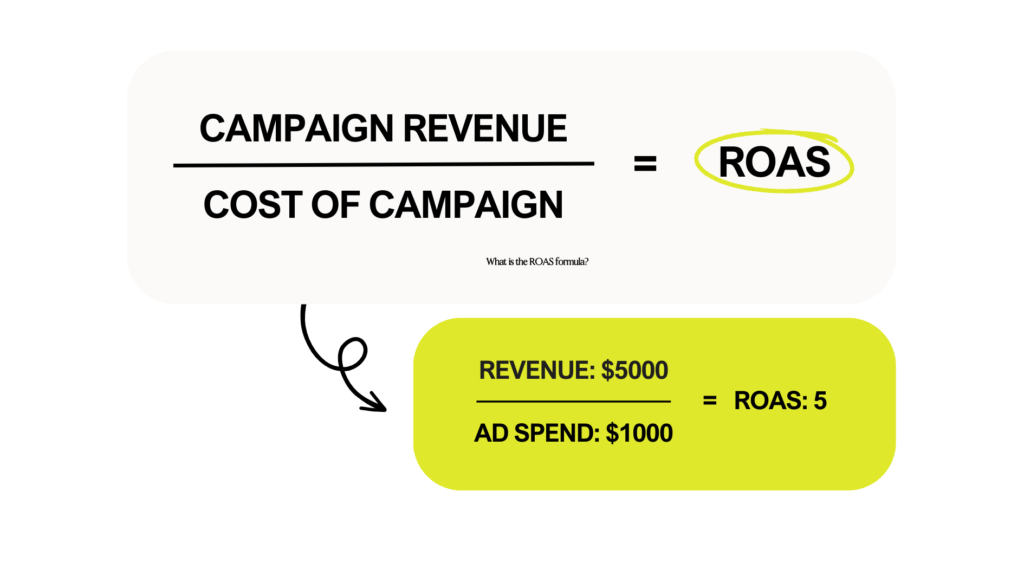For brands, UGC is a small piece of the larger marketing pie. As a UGC creator, if you want to take your game to the next level, you need to understand the ins-and-outs of the bigger pie. The best place to start? ROAS.
ROAS — return on ad spend — is a marketing metric that helps advertisers, aka your clients, gauge the success of their advertising by quantifying the return they receive relative to how much they spend.
In plain English, it tells them how much revenue a campaign is generating for every dollar spent. A higher ROAS means that a campaign is performing well, a lower ROAS is a flop.
As a creator, being able to put a cold number against the effectiveness of your UGC content can be a gamechanger when you’re trying to land bigger deals. Here’s everything you need to know about ROAS (and how to use it as a UGC creator).
What is ROAS?
I’ve already covered it briefly: ROAS stands for return on ad spend — a metric that measures the amount of revenue your business earns for each dollar it spends on advertising.
At the most basic level, ROAS measures the effectiveness of your advertising efforts; the more effectively your advertising messages connect with your prospects, the more revenue you’ll earn from each dollar of ad spend. The higher your clients ROAS, the better.
Return On Ad Spend Formula
Because ROAS is such an important part of the pie, many assume that it’s a hassle to calculate. Luckily, the opposite is true: the ROAS formula is incredibly simple. ROAS equals your total campaign revenue divided by the advertising costs.

What Is A Good ROAS for Ads?
Ok, so lets say you’ve asked a brand for the ROAS, and they’ve hit you with 1.5. What does that even mean?
An acceptable ROAS will be influenced by profit margins, so while there’s no “right” answer, a common ROAS benchmark is a 4:1 ratio — $4 revenue to $1 in ad spend.
A value greater than 1 means that the business is breaking even, but this doesn’t account for the cost of goods. Yes, they can cover their marketing costs with revenue, but depending on how large their profit margins are, they might still be operating at a loss.
Minimum, you should be looking for a ROAS of 2.5.
How To Use ROAS As A UGC Creator
Ask For It
If you find it hard to justify your rates to your clients, or you’re just lacking the confidence to do so, start by asking for the ROAS. ROAS measures how effective the campaign was: imagine being able to tell brands that your creatives generated a 5x ROAS with a $5k ad spend. That means your creatives generated $25,000 in revenue. Suddenly, your $500 rate doesn’t sound so outlandish. It shifts the pricing conversations to focus on the actual impact your creatives have on driving revenue and helps brands understand the value of their investment.
Don’t overthink how you ask for this, set a reminder to ask the brand 30 days or so after you’ve sent over your deliverables. ‘Hi Client X, would you be able to share the revenue generated and the ad spend for our recent collaboration? I’d like to be able to analyze the ROAS and performance of the creative.’
Add It To Your Portfolio
Having hard figures in your UGC portfolio makes it easier to negotiate later down the line. In fact, with good evidence of the return on investment a brand can expect from your services, you won’t need to negotiate at all. Your rates are your rates, because what you’re doing works.
Be Prepared For Some Hard Truths
A low ROAS doesn’t necessarily mean your creative was bad, but it definitely means you need to analyze your content. Having a figure that measures the effectiveness of an ad can give you the information you need to make data driven decisions going forward. If the ROAS is low, why not make suggestions to the brand as to how you could improve the concept? Hook variations, mash-ups with other creators or a different visual hook could be the key to success. By doing so, you show that you’re invested in the brand’s success — not just a one-off collaboration.
Start Treating UGC Like A Business
Brands are going to use ROAS data to make informed decisions about budget allocation, channel selection, and campaign optimization. You should be using it too.
While ROAS is a powerful metric, it’s important to note that it doesn’t provide a complete picture of overall ad performance — it’s not solely reflective of your creative: the ad could also be set up with dodgy targeting, headlines or copy that falls flat. The important thing is that you analyze your own deliverables.
Understand how to use it, and it can be your secret weapon to stand out in a crowded marketplace.